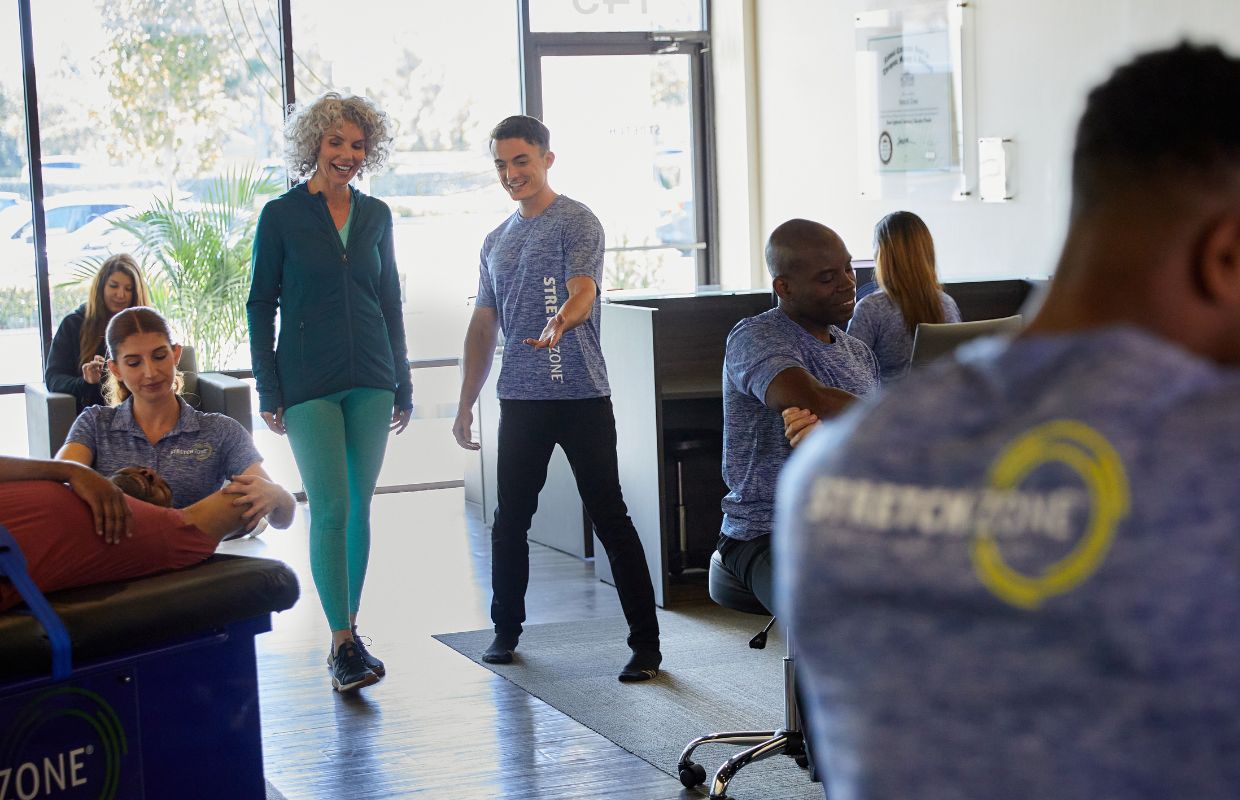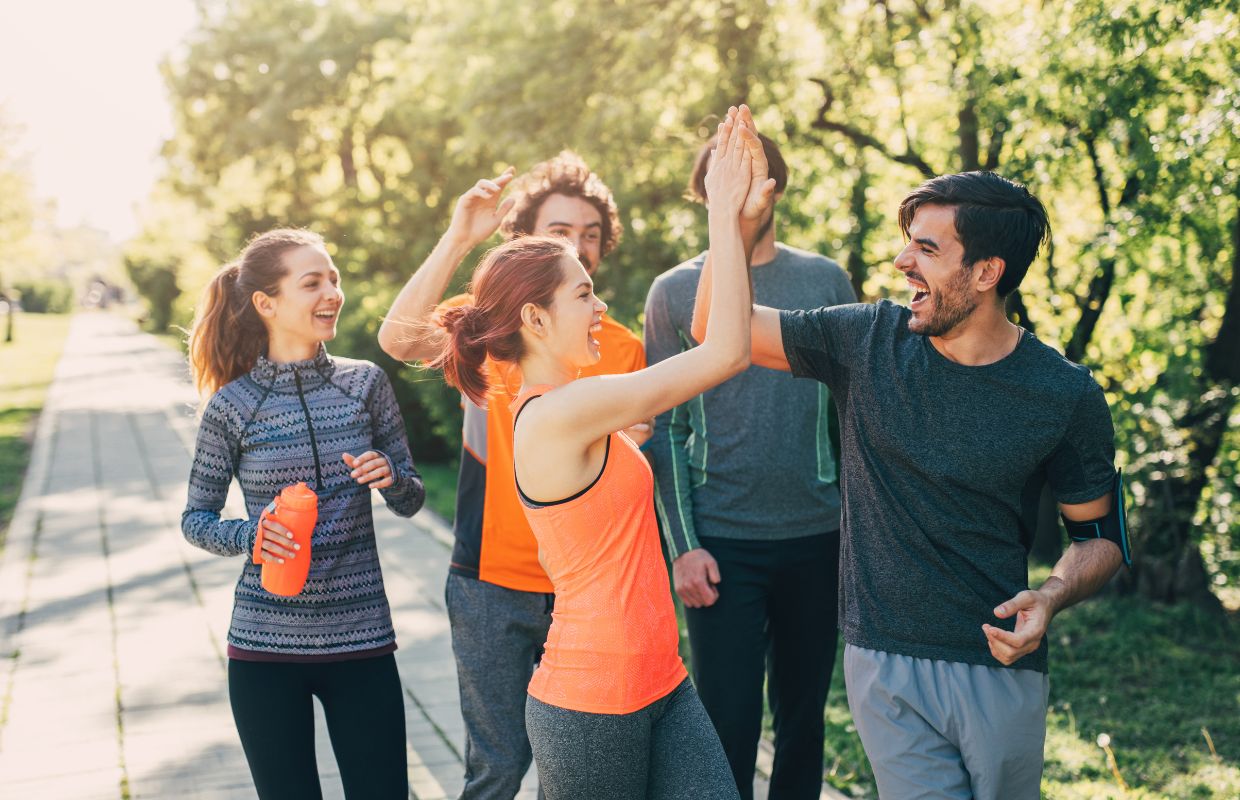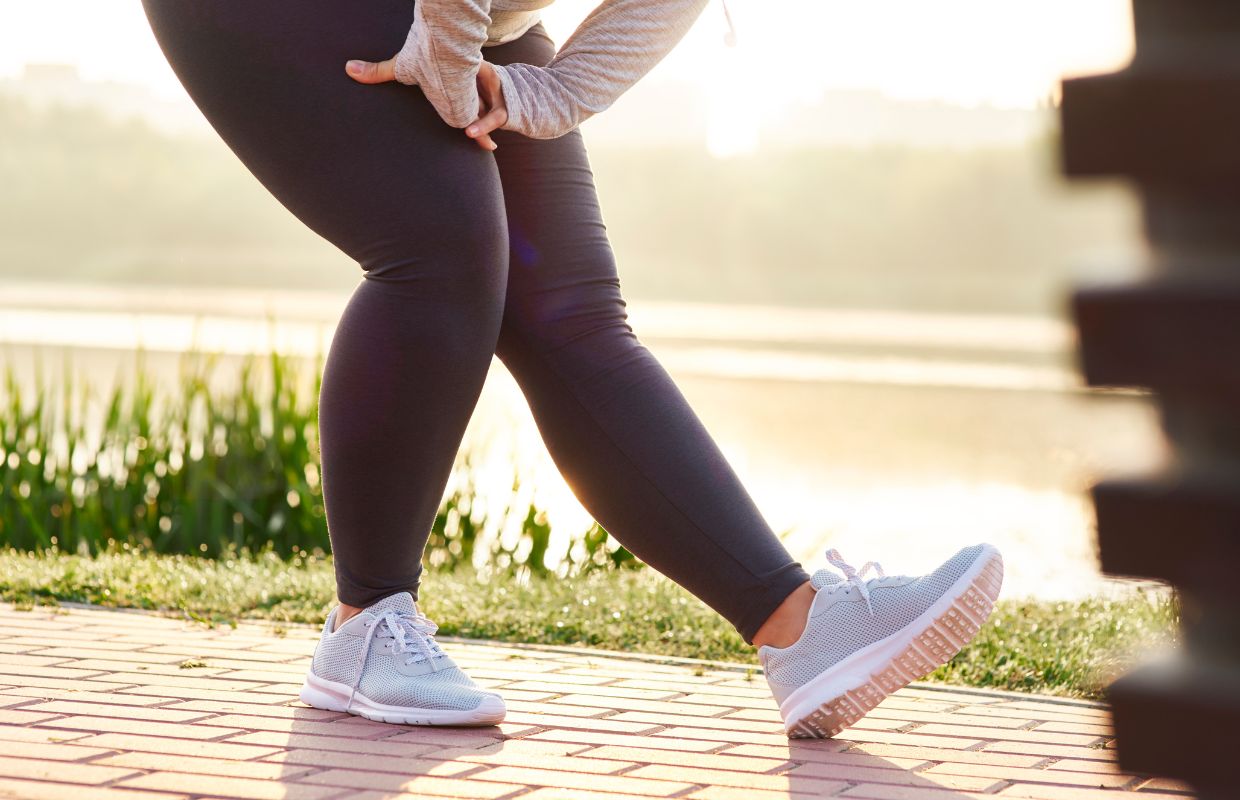
New to Stretching? Here’s What You Should Expect
Stretching is a powerful tool for enhancing flexibility, mobility, and overall muscle health. One popular form of the activity is active stretching, which requires active participation and engagement during the process.
Let’s delve into the world of active stretching and what you should expect when working with a professional stretch practitioner. By the end, you’ll clearly understand the importance and advantages of practitioner-assisted stretching.
What Are the Fundamentals of Active Stretching?
At its core, active stretching involves using your own muscles to create tension and resistance, promoting a greater joint range of motion and increased flexibility. Unlike passive stretching, where external forces move your body, active stretching empowers you to take charge of your movements, making it an engaging and dynamic form of stretching.
Engaging your muscles during the stretch activates the reciprocal inhibition reflex, which signals the opposing muscle to relax. This allows for a deeper, more effective stretch that can help increase flexibility and mobility over time. Stretch practitioners play a crucial role in guiding their clients through active stretching sessions by demonstrating proper form and ensuring each move is executed safely and effectively.
Understanding the Benefits
The advantages of active stretching are far-reaching, extending beyond simply enhancing flexibility. Let’s delve into these many benefits:
Improved Flexibility and Range of Motion
One of the primary benefits of active stretching is the significant improvement in flexibility and joint range of motion. You encourage your muscles to elongate and adapt to new positions by actively engaging them during each session. Over time, this increases flexibility, allowing you to move more freely and comfortably in your daily activities and exercise routines.
Reduced Muscle Tension and Improved Muscle Control
Since active stretching targets specific muscle groups, it can promote relaxation and release built-up tension. Incorporating this activity into your routine can alleviate muscle tightness and improve overall muscle control.
Individuals with sedentary lifestyles or those who experience muscle stiffness from prolonged sitting or repetitive movements may find active stretching particularly beneficial.
Enhanced Athletic Performance and Injury Prevention
Athletes and fitness enthusiasts often incorporate active stretching into their training routines to optimize performance and reduce the risk of injuries. Improved flexibility and range of motion enable better movement efficiency and mechanics during sports and other physical activities.
Additionally, you can help prevent strains, sprains, and other exercise-related injuries by warming up and engaging the muscles through active stretching before exercise.
Stress Relief and Psychological Benefits
Active stretching can be a therapeutic experience, offering stress relief and psychological benefits. As you focus on your body and its movements, you cultivate a sense of mindfulness and presence in the moment. This increased mind-body connection can help reduce stress and anxiety, allowing you to unwind and mentally and physically recharge.
Improved Posture and Body Alignment
Active stretching can also contribute to better posture and body alignment. You can gradually correct imbalances and encourage a more aligned and balanced body by targeting tight muscles due to poor posture or lifestyle habits.
Better Circulation and Blood Flow
During active stretching, blood flow to the stretched muscles increases, delivering essential nutrients and oxygen while removing waste products. Improved circulation can aid in muscle recovery and contribute to overall cardiovascular health.
Enhanced Performance in Daily Activities
As flexibility and mobility improve through active stretching, you’ll likely notice enhanced performance in your everyday activities. For example, simple tasks like bending, reaching, and lifting become easier and more fluid, improving your overall quality of life.
Incorporating active stretching into your routine, whether part of a warm-up or a dedicated practice, can lead to many physical and mental benefits. Remember that consistency is key; regular practice allows you to experience the full advantages of active stretching.
Active Stretching and the Holistic Approach to Health
A holistic approach to health considers the mind, body, and spirit interconnectedness, recognizing that each aspect influences overall well-being. Active stretching is essential to this approach, contributing to the harmonious balance of physical, mental, and emotional health.
Let’s explore how active stretching aligns with the principles of a holistic lifestyle:
- Physical Wellness: Active stretching directly impacts physical wellness by improving flexibility, mobility, and muscle health.
- Mental Clarity and Emotional Well-Being: Setting aside time for yourself during active stretching sessions creates a space for introspection and self-discovery.
- Stress Reduction and Mindfulness: Active stretching offers an opportunity to disconnect from the hustle and bustle of daily life and cultivate a sense of mindfulness.
- Complementary to Other Forms of Exercise Incorporating active stretching into your fitness routine complements other forms of exercise, such as strength training, cardiovascular activities, and yoga.
- Encourages Holistic Self-Care: By prioritizing active stretching, you prioritize your overall well-being and create space to nurture yourself physically, mentally, and emotionally.
- Longevity and Quality of Life: Active stretching empowers you to continue enjoying your favorite activities and pursuing new experiences with vitality and enthusiasm.
What to Expect in a Stretching Session
An active stretching session with a stretch practitioner is a personalized and guided experience to maximize the benefits of active stretching for everyone. Understanding the process will help you make the most of your stretching journey and reap the rewards of this effective stretching technique.
Let’s walk through a step-by-step overview of what typically happens during a stretch session:
- Step 1 – The Initial Assessment: The session begins with an initial assessment, where the stretch practitioner takes the time to understand the client’s specific needs, goals, and any areas of concern. This assessment may involve discussing the client’s medical history, previous injuries, and current physical activity level.
- Step 2 – Postural Analysis: The stretch practitioner may conduct a postural analysis to identify any postural imbalances or alignment issues that could be addressed through active stretching. This analysis helps tailor the stretching routine to focus on specific muscle groups that may require attention.
- Step 3 – Personalized Stretching Routine: Based on the assessment and postural analysis, the stretch practitioner customizes a stretching routine unique to the client. It may include various stretches targeting different muscle groups and joint movements to address specific needs and goals.
- Step 4 – Guided Stretching: The professional guides the client through the practitioner-assisted stretching routine. They ensure the client maintains the correct posture and engages the appropriate muscles during each move for optimal results.
- Step 5 – Gradual Progression: Throughout the session, the stretch practitioner gradually increases the intensity of the stretches without causing discomfort. They promote a mindful approach to stretching, emphasizing the importance of listening to the body’s cues and avoiding overexertion.
- Step 6 – Communication and Feedback: Open communication between the client and stretch practitioner is vital during the session. The client is encouraged to share their sensations and comfort levels, allowing the practitioner to make any necessary adjustments to the routine.
- Step 7 – Cool Down and Relaxation: After completing the stretching routine, the stretch practitioner may guide the client through a cool-down phase, which involves gentle movements to relax the muscles and bring the body back to a more neutral state. This cool-down phase also helps prevent post-stretching soreness.
The stretch practitioner’s expertise allows for a safe and effective stretching experience, ensuring the client gets the most out of each move while minimizing the risk of injury. They play a vital role in adjusting the routine as needed to accommodate individual progress and changes in the client’s physical condition.
An active stretching session with a stretch practitioner focuses on creating a positive and supportive environment, promoting a deeper mind-body connection, and enhancing the overall stretching experience.
The Crucial Role of Stretch Practitioners
Stretch practitioners play a vital role in guiding individuals safely through active stretching sessions. Their expertise, qualifications, and support are instrumental in ensuring clients achieve the best possible outcomes from their stretching routines.
Let’s explore some of the other essential aspects of their role:
Expertise and Qualifications
Stretch practitioners undergo specialized training in anatomy, physiology, and biomechanics. This extensive knowledge enables them to understand how different muscles and joints interact and how to effectively stretch them without causing harm. They are well-versed in various stretching techniques and can tailor routines to address specific client needs and goals.
Personalized Approach
Stretch practitioners take a personalized approach to each client’s stretching journey. Through initial assessments and postural analysis, they identify individual strengths, weaknesses, and areas requiring attention. This tailored approach allows them to create stretching routines focusing on specific muscle groups and effectively address any imbalances or restrictions.
Guidance and Safety
During active stretching sessions, practitioners provide hands-on guidance to ensure clients maintain proper form and alignment. This helps prevent injuries and ensures the moves effectively target the intended muscles. They encourage gradual progress and adapt the routine to accommodate changes in the client’s physical condition and progress over time.
Open Communication
Effective communication between clients and stretch practitioners is paramount. Clients are encouraged to share their sensations, comfort levels, and concerns during the stretching session. This open dialogue allows the practitioner to make real-time adjustments to the routine and address any discomfort or challenges the client may be experiencing.
Working with a stretch practitioner allows you to receive personalized attention and feedback, maximizing the benefits of your stretching routine. They can also tailor the stretches to address specific areas of concern or target muscles requiring extra attention.
Motivation and Support
Stretch practitioners act as motivators and supporters throughout the stretching session. Their encouraging demeanor helps clients stay engaged and committed to their goals. By fostering a positive and supportive environment, stretch practitioners inspire clients to explore their full potential and make progress in their flexibility and mobility journey.
Common Misconceptions about Active Stretching
Despite its numerous benefits, active stretching often faces misconceptions that can deter many from trying this effective form of stretching. Fortunately, by working with a stretch practitioner, individuals can ensure a safe and effective stretching experience.
Let’s address some of these misconceptions and myths surrounding active stretching and shed light on the reality of this practice:
Misconception 1: Active Stretching Should Hurt
Reality: One of the most prevalent misconceptions about active stretching is that it should hurt to be effective. Active stretching should never cause aches. On the contrary, the activity should focus on comfort and gradual progress to avoid strain or injury.
While you may experience mild discomfort as you challenge your muscles, it should never be an excruciating or unbearable feeling. Active stretching respects the body’s limits to avoid pulling or tearing a muscle.
Misconception 2: Active Stretching is Only for Athletes or Highly Flexible Individuals
Reality: Active stretching benefits individuals of all fitness levels and body types. You don’t need to be an athlete or naturally flexible to engage in active stretching. In fact, the activity is particularly helpful for those with limited flexibility, as it gradually improves range of motion and muscle control over time.
Misconception 3: Active Stretching Takes Too Much Time
Reality: Active stretching can be tailored to fit various time constraints. Even short stretching sessions can provide benefits. Incorporating just a few minutes of active stretching into your daily routine can greatly improve your flexibility and overall well-being.
Misconception 4: Active Stretching Is Not Suitable for Older Adults
Reality: Active stretching can be adapted to suit the needs and capabilities of older adults. It can help improve joint health, reduce stiffness, and enhance mobility, making it an excellent practice for individuals of all ages.
Misconception 5: You Can Achieve Results Quickly with Active Stretching.
Reality: Flexibility and mobility improvements through active stretching take time and consistency. Like any form of exercise, patience is key. Gradual progress and regular practice yield more sustainable and long-lasting results.
Misconception 6: Static Stretching is More Effective Than Active Stretching.
Reality: Both static and active stretching have their benefits. Active stretching is more suitable for preparing the body for physical activity, as it activates and warms up the muscles to improve performance and reduce the risk of injury. Static stretching, on the other hand, is often recommended after exercise to cool down and further improve flexibility.
Ready to Get Started on Your Active Stretching Journey?
Active stretching is a powerful and transformative practice with many benefits for both body and mind. The role of stretch practitioners at Stretch Zone is indispensable in guiding you safely through your active stretching journey. With the guidance of a stretching professional, you can explore your body’s full potential and embrace a more flexible and healthier lifestyle.
Discover the magic that active stretching can bring to your life and take the first step toward a more vibrant and active you. There’s a Stretch Zone in your area that awaits with open arms to guide you on this incredible journey of self-improvement and growth. Book a session today, and let’s stretch toward a healthier and more flexible tomorrow!


